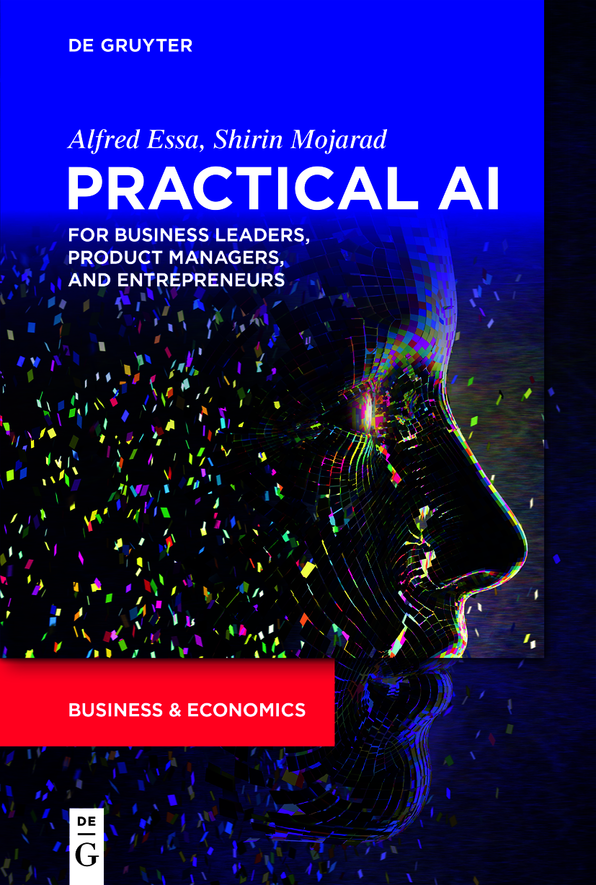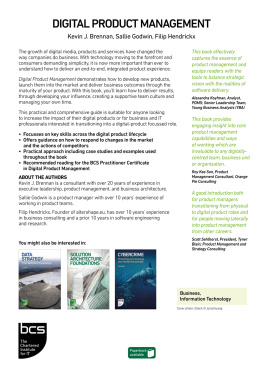Alfred Essa - Practical AI for Business Leaders, Product Managers, and Entrepreneurs
Here you can read online Alfred Essa - Practical AI for Business Leaders, Product Managers, and Entrepreneurs full text of the book (entire story) in english for free. Download pdf and epub, get meaning, cover and reviews about this ebook. year: 2022, publisher: De Gruyter, genre: Children. Description of the work, (preface) as well as reviews are available. Best literature library LitArk.com created for fans of good reading and offers a wide selection of genres:
Romance novel
Science fiction
Adventure
Detective
Science
History
Home and family
Prose
Art
Politics
Computer
Non-fiction
Religion
Business
Children
Humor
Choose a favorite category and find really read worthwhile books. Enjoy immersion in the world of imagination, feel the emotions of the characters or learn something new for yourself, make an fascinating discovery.

- Book:Practical AI for Business Leaders, Product Managers, and Entrepreneurs
- Author:
- Publisher:De Gruyter
- Genre:
- Year:2022
- Rating:4 / 5
- Favourites:Add to favourites
- Your mark:
- 80
- 1
- 2
- 3
- 4
- 5
Practical AI for Business Leaders, Product Managers, and Entrepreneurs: summary, description and annotation
We offer to read an annotation, description, summary or preface (depends on what the author of the book "Practical AI for Business Leaders, Product Managers, and Entrepreneurs" wrote himself). If you haven't found the necessary information about the book — write in the comments, we will try to find it.
Alfred Essa: author's other books
Who wrote Practical AI for Business Leaders, Product Managers, and Entrepreneurs? Find out the surname, the name of the author of the book and a list of all author's works by series.
Practical AI for Business Leaders, Product Managers, and Entrepreneurs — read online for free the complete book (whole text) full work
Below is the text of the book, divided by pages. System saving the place of the last page read, allows you to conveniently read the book "Practical AI for Business Leaders, Product Managers, and Entrepreneurs" online for free, without having to search again every time where you left off. Put a bookmark, and you can go to the page where you finished reading at any time.
Font size:
Interval:
Bookmark:

ISBN 9781501514647
e-ISBN (PDF) 9781501505737
e-ISBN (EPUB) 9781501505843
Bibliographic information published by the Deutsche Nationalbibliothek
The Deutsche Nationalbibliothek lists this publication in the Deutsche Nationalbibliografie; detailed bibliographic data are available on the Internet at http://dnb.dnb.de.
2022 Walter de Gruyter Inc., Boston/Berlin
For Setsu.
Alfred Essa
To my mom, dad and brother.
Shirin Mojarad
AI is a team sport. We would like to thank our former data science team members at McGraw Hill Education for their inspiration and for making us better data scientists: Ani Aghababyan, Lalitha Agnihotri, Jacqueline Feild, Nicholas Lewkow, Mark Riedesel, and Neil Zimmerman.
There are many books available about artificial intelligence (AI) and machine learning. Ours is a technical work aimed at a non-technical audience. We have written the book primarily for business leaders, managers, and entrepreneurs. But it is intended for anyone responsible, or likely to be responsible, for leading AI-related initiatives in their organization. Our goal is to provide a solid technical foundation for applying AI to solve business problems, old and new. We hope that the book will also be of interest to students as an introductory guide; to practitioners who need to review foundational topics; and to citizens who need to assess the ethical implications of AI.
There is a broad consensus among economists that AI is not just another technology, but a general purpose technology (GPT) like the steam engine, electricity, and the computer. GPTs are engines of growth: they are pervasive, improve over time, and lead to complementary innovations. As a GPT, AI is poised to drive innovation in every sector of the national and global economy for the foreseeable future. But economists have also cautioned that the full potential of a GPT, including AI, can only be unlocked when firms find new ways to integrate culture, business, and technology. AI is important because firms led by AI-savvy business leaders will drive the next wave of innovation and seize competitive advantage in the new economy. AI also introduces deep ethical challenges. To seize the opportunities and to meet the challenges, leaders will need to develop a sound technical understanding of how AI works but also recognize its inherent limitations.
Each major topic is presented in three separate chapters: concept, theory, and practice. The concept chapters introduce core concepts with the aim of building a solid intuition. We take a direct route to the topic at hand, without fuss and without too much detail. Each concept chapter contains a case study to emphasize the books practical nature.
The theory chapter peeks underneath the hood to reveal the machinery behind the concepts. Mathematics is unavoidable, but it need not be forbidding. The power of AI is based on the new science of computation. And the power of computational AI is based on linear algebra and the power of vectors and matrices. The theory chapters, therefore, are also meant to provide a gentle introduction to computational thinking.
The practice chapters provide code in Python to implement the models discussed in the case studies. The code is real code with real examples. Most of the models we discuss can be implemented in 1020 lines of Python code. This is not to suggest that production-ready code is simple or easy. Far from it. But our approach to coding is to get to the essence of building AI models. The habit of thinking in terms of models develops by viewing and running code in its simplest possible form.
Our coverage of deep learning is organized somewhat differently. We emphasize five foundational principles, dedicating a chapter to each. As before, a practice chapter with code is provided to reinforce key topics.
We have dedicated an entire part of the book, consisting of three chapters to model assessment. The first chapter emphasizes the inherent tradeoff in model development between reducing model error and increasing model generality, the bias-variance tradeoff. The second chapter is dedicated to assessing regression models and the third chapter to assessing classification models.
We assume familiarity with college algebra and a nodding familiarity with trigonometry. But more important is a willingness to wade into the waters of abstract thinking. Mastery takes time, patience, and practice. But the rewards of AI, as a system of thought and practice, are well worth knowing and mastering.
Our goal has been to highlight key ideas and foundational principles. AI is a vast field and we have not tried to be exhaustive in our coverage. For example, our discussion of deep learning focuses on the core, leaving out specific varieties such as convolutional and recurrent neural networks. We have also left out topics such as dimensionality reduction (e.g., Principal Component Analysis), which is part of unsupervised learning. Our aim is to provide a strong base so that the reader can pursue specialized topics as needed with confidence.
Each chapter begins with a list of key ideas. The key ideas are meant to serve as landmarks. After finishing each chapter, the reader should return to the list as a diagnostic for comprehension and further study. The code examples in the practice chapters should also be studied in light of the key ideas.
The code examples and the dataset are all available at the books website: http://practical-ai.org. The Jupyter notebooks can be run directly on the cloud or downloaded from GitHub. Instructions for both are available on the website. The authors maintain two versions of the notebooks. The quick version matches the code in the book. The extended version includes additional code, with elaboration and further examples, for readers who wish to do a deeper dive into the topics covered in the book.
In the introduction, we briefly describe the history of AI research: the key distinction is between general and narrow AI. We then define machine learning, a form of narrow AI. The books focus is machine learning and deep learning, both are subbranches of narrow AI. We conclude by sketching the basic steps of building machine learning and deep learning models.
The dream of artificial intelligence goes back centuries. Its connection to computing was articulated most clearly by the German mathematician and philosopher Gottfried Wilhelm Leibniz (), a co-inventor of calculus with Sir Isaac Newton. In 1666, Leibniz published On the Combinatorial Art, in which he postulated that all human thought rests on atomic concepts; that these atomic concepts can be represented symbolically; and that compound concepts can be generated combinatorially with automated rules.

Figure 1.1 Gottfried Wilhelm Leibniz (16461716). Painting by Christoph Bernhard Francke. Wikicommons. Creative Commons Licence CC0.
Leibniz also imagined a machine which he called the great instrument of reason. Leibnizs machine would be based on three things: an alphabet of human thoughts represented symbolically in a formal language; a set of logical rules for combining and recombining the alphabet; and the mechanical device itself, which could carry out the operations of combination and recombination.
Font size:
Interval:
Bookmark:
Similar books «Practical AI for Business Leaders, Product Managers, and Entrepreneurs»
Look at similar books to Practical AI for Business Leaders, Product Managers, and Entrepreneurs. We have selected literature similar in name and meaning in the hope of providing readers with more options to find new, interesting, not yet read works.
Discussion, reviews of the book Practical AI for Business Leaders, Product Managers, and Entrepreneurs and just readers' own opinions. Leave your comments, write what you think about the work, its meaning or the main characters. Specify what exactly you liked and what you didn't like, and why you think so.







